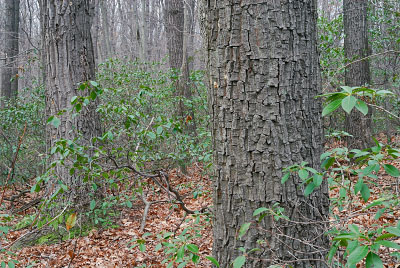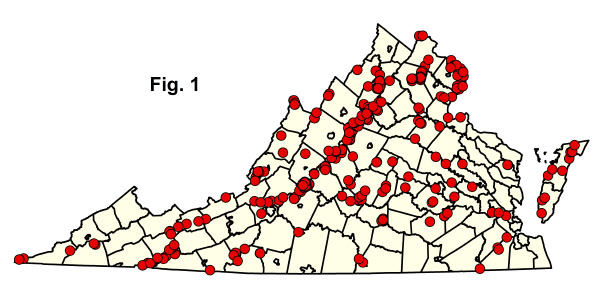
 የጥበቃ እና መዝናኛ መምሪያ
የጥበቃ እና መዝናኛ መምሪያ መጠበቅ. መከላከል. መደሰት.
 የጥበቃ እና መዝናኛ መምሪያ
የጥበቃ እና መዝናኛ መምሪያ  ማውጫ
ማውጫየኦክ / ሄዝ ደኖች
This group of oak-dominated forests is prevalent on xeric, infertile upland sites in every physiographic province of Virginia, and is wide-ranging in the Appalachians and adjacent provinces outside of the Commonwealth. In some cases, particularly in the mountains and foothills, these communities have replaced former mixed oak - American chestnut (Castanea dentata) forests following the decimation of chestnut overstory trees by an introduced fungal blight (Cryphonectria parasitica) early in the twentieth century. Habitats are variable, ranging from sterile, low-elevation "flatwoods" to steep, rocky mountainsides. All have soils with a distinctly oligotrophic nutrient regime, i.e., strongly acidic, with low base cation levels and relatively high levels of iron. Accumulations of thick duff and high biomass of inflammable shrubs in these forests make them susceptible to periodic fires, which in turn favors recruitment of oaks. Regionally varying mixtures of white oak (Quercus alba), chestnut oak (Quercus montana), scarlet oak (Quercus coccinea), black oak (Quercus velutina), northern red oak (Quercus rubra), southern red oak (Quercus falcata), and post oak (Quercus stellata) compose the overstories of these forests. Bigtooth aspen (Populus grandidentata) and pines - including pitch pine (Pinus rigida) in the mountains, shortleaf and Virginia pines (Pinus echinata and Pinus virginiana) in the Piedmont, and loblolly pine (Pinus taeda) in the Coastal Plain - are common associates that usually indicate past disturbance. Hickories (Carya spp.) are generally unimportant and, when present, mostly restricted to the understory.

Forests overwhelmingly dominated by chestnut oak (Quercus montana, = Quercus prinus) are widespread on sandstone or quartzite ridges in the mountains, but occur locally on monadnocks, foothills, and rocky or gravelly bluffs throughout the Piedmont and inner Coastal Plain. On gentler, low-elevation terrain of eastern Virginia and the mountain valleys, white oak is more prominent in mixtures with several other oaks. Blackgum (Nyssa sylvatica) and sourwood (Oxydendrum arboreum) are frequent overstory associates and abundant understory trees, along with sassafras (Sassafras albidum) and downy serviceberry (Amelanchier arborea). Decades of fire suppression or exclusion has led to a general abundance of the fire-intolerant red maple (Acer rubrum) in oak / heath forest understories. Ericaceous (heath-family) plants, including mountain laurel (Kalmia latifolia), black huckleberry (Gaylussacia baccata), wild azalea (Rhododendron periclymenoides), and blueberries (Vaccinium spp.), form dense colonies in the shrub and herb layers. Evergreen rhododendrons (Rhododendron maximum and Rhododendron catawbiense) and flame azalea (Rhododendron calendulaceum) are locally prevalent members of the ericaceous shrub complex in the mountains, while dangleberry (Gaylussacia frondosa) is a prominent ericad in the Coastal Plain. The ericaceous sub-shrubs trailing arbutus (Epigaea repens) and wintergreen (Gaultheria procumbens) may also be abundant, especially in the mountains. The density of ericaceous species may be closely tied to land-use and disturbance history. True herbaceous species are sparse, but may include scattered individuals or colonies of xerophytes such as galax (Galax urceolata), yellow wild indigo (Baptisia tinctoria), pink lady's-slipper (Cypripedium acaule), dwarf iris (Iris verna), large whorled pogonia (Isotria verticillata), cancer-root (Orobanche uniflora), gaywings (Polygaloides paucifolia), eastern bracken fern (Pteridium aquilinum ssp. latiusculum), and Virginia goat's-rue (Tephrosia virginiana).
በዚህ ቡድን ውስጥ ያሉ የማህበረሰብ ዓይነቶች በቨርጂኒያ የመሬት ገጽታ ላይ ሰፊ የሆነ የማትሪክስ ወይም ትልቅ-ፕላች እፅዋትን ይመሰርታሉ። ምንም እንኳን በአንፃራዊነት ሰፋ ያሉ ቢሆንም፣ ግልጽ መቁረጥን፣ ወደ ጥድ ተክል ሥልቪካልቸር መለወጥ፣ የጂፕሲ የእሳት እራት መበከል፣ የእሳት ቃጠሎን እና በልማት መጥፋትን ጨምሮ ለብዙ ረብሻዎች ተዳርገዋል። ነገር ግን፣ በቨርጂኒያ ውስጥ በሚገኙ ደረቅ ተራራዎች ላይ በርካታ የኦክ ዛፍ የበላይ የሆኑ ቆሞዎች በመቀነሱ እድገት እና ከመጠን በላይ ባለ ዛፎች ቅርጻቸው ከመቁረጥ ተርፈዋል።
ዋቢ፡ Abrams et al . (1997) ፣ አዳምስ እና ስቴፈንሰን (1983) ፣ አላርድ እና ሊዮናርድ (1943) ፣ ክላርክ እና ዋሬ (1980) ፣ ኮል እና ዋሬ (1997) ፣ ኩሊሊንግ እና ራዊንስኪ (1999) ፣ ክሩች (1990) ፣ ፋረል እና ዋሬ (1988) ፣ ፍሌሚንግ (2002ሀ ) ፣ ፍሌሚንግ (2002 ) ፣ ፍሌሚንግ (2007) ኩሊንግ (2001)፣ ፍሌሚንግ እና ሙርሄድ (1996)፣ ፍሌሚንግ እና ሙርሄድ (2000)፣ ፍሌሚንግ እና ዌበር (2003)፣ ጂምቦሪስ (1974)፣ ሃሪሰን እና ሌሎችም ። (1989)፣ ጆንሰን እና ዋሬ (1982)፣ ማርቲን እና ሌሎች ። (1982)፣ ማኮይ እና ፍሌሚንግ (2000)፣ McEvoy et al . (1980)፣ ኦልሰን እና ሁፕ (1986)፣ ኦርዊግ እና አብራምስ (1994)፣ Rawinski et al . (1994), Rawinski et al . (1996) ፣ ሮድስ (1992) ፣ ሮድስ (1995) ፣ ሮድስ (2002) ፣ ስቴፈንሰን (1974) ፣ ስቴፈንሰን (1982ሀ ) ፣ ስቴፈንሰን እና አዳምስ (1991) ፣ ስቴፈንሰን እና ፎርትኒ (1998) ፣ ቫንደርሆርስት (2000) ፣ ዋልተን እና ሌሎችም። (2001)፣ Ware (1991)።የዚህን የስነምህዳር ማህበረሰብ ቡድን ተጨማሪ ፎቶዎች ለማግኘት እዚህ ጠቅ ያድርጉ ።
 © DCR-DNH, ጋሪ ፒ. ፍሌሚንግ.
© DCR-DNH, ጋሪ ፒ. ፍሌሚንግ.
በቨርጂኒያ ውስጥ ከ 300 በላይ የዚህ ተክል ቦታዎች ናሙና ተወስደዋል (ምስል 1) እና ዘጠኝ የማህበረሰብ ዓይነቶች በበርካታ ክልላዊ ትንታኔዎች ተመድበዋል። አብዛኛዎቹ እነዚህ በጣም ጥሩ ደረጃ ያላቸው ክፍሎች በጠንካራ ጂኦግራፊያዊ/ከፍታ ደረጃዎች እና በተያያዙ የአበባው ልዩነት ተለይተው ይታወቃሉ። ነገር ግን፣ የ"ማዕከላዊ አፓላቺያን" እና "የደቡብ አፓላቺያን" አሃዶች መለያየት በተለይ በምእራብ ቨርጂኒያ ውስጥ ችግር ያለበት ሲሆን የእነዚህ ባዮጂኦግራፊያዊ ክልሎች እፅዋት ብዙ ጊዜ በማይሰማቸው ሁኔታ ይዋሃዳሉ። በ NatureServe Explorer የቀረበውን አለምአቀፍ የUSNVC መግለጫ ለማየት ከታች ባለው ማንኛውም የደመቀ CEGL ኮድ ላይ ጠቅ ያድርጉ። ከዚህ በታች ለተዘረዘሩት ለእያንዳንዱ የማህበረሰብ ዓይነቶች የተቀናበረ ማጠቃለያ ስታቲስቲክስ የተመን ሉህ ያውርዱ 
 ።
።

